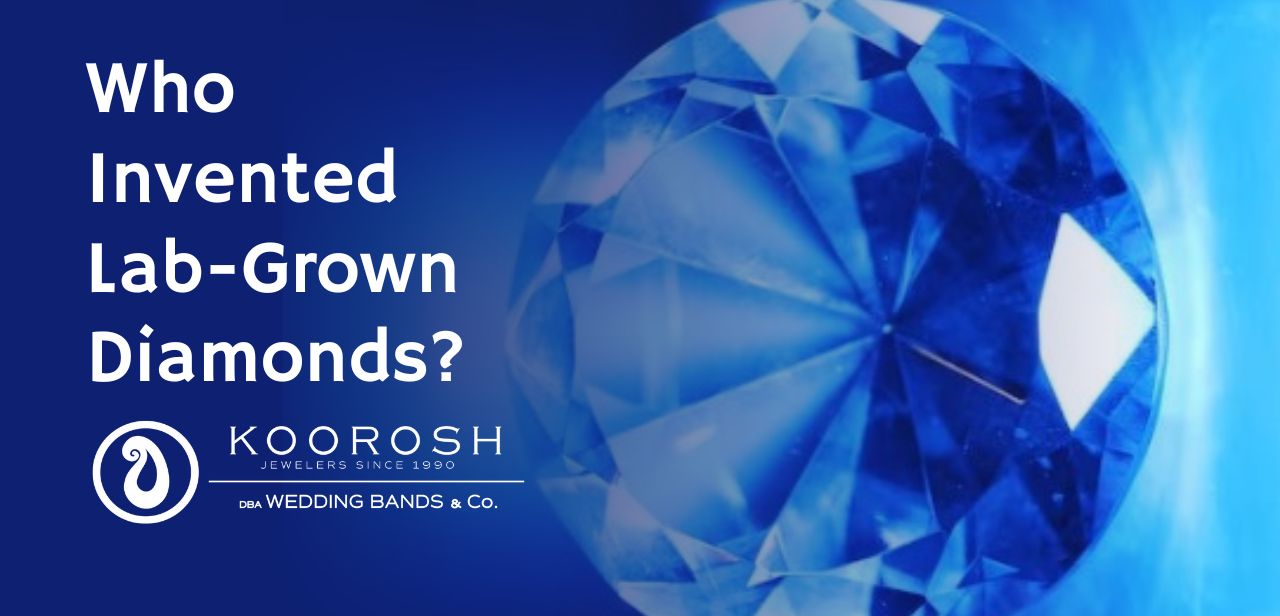Who Invented Lab-Grown Diamonds?
Posted by Koorosh Daneshgar on Jan 19th 2023

Lab-grown diamonds are diamonds that are created in a laboratory setting, rather than being mined from the earth. The process of creating lab-grown diamonds is relatively new, dating back to the 1950s, but it has rapidly grown in popularity in recent years due to a number of factors, including its environmental and ethical benefits.
The first lab-grown diamond was created in the 1950s by a team of scientists at the General Electric Company. The scientists, led by Dr. William R. L. Lyman, developed a method for growing diamonds using a process known as high pressure, high temperature (HPHT) synthesis. This process involves subjecting a small diamond seed to extreme pressure and heat, mimicking the natural conditions in which diamonds form in the earth. The result is a diamond that is virtually identical to a natural diamond in terms of its physical and chemical properties.
In the 1970s and 1980s, another method of lab-grown diamond synthesis was developed, known as chemical vapor deposition (CVD). This process involves introducing a mixture of gases into a chamber and applying heat and a plasma to create a diamond film on a substrate. CVD lab-grown diamonds are typically smaller than HPHT lab-grown diamonds and are used for industrial and scientific applications.
Despite the invention of lab-grown diamonds in the 1950s, it wasn't until the 1990s that the technology became widely available to the public. This was due in part to the high cost and complexity of the HPHT and CVD processes, which made it difficult for small companies and individual consumers to access. However, as the technology has evolved and improved over time, the cost of lab-grown diamonds has come down significantly, making them more affordable and accessible to a wider range of people.

Today, lab-grown diamonds are becoming increasingly popular among consumers for a number of reasons. One of the main benefits of lab-grown diamonds is that they are more environmentally friendly than natural diamonds. Diamond mining is a resource-intensive process that can have negative impacts on the environment, including deforestation, soil erosion, and water pollution. Lab-grown diamonds, on the other hand, are created using a controlled process that generates minimal waste and has a much smaller environmental footprint.
Another benefit of lab-grown diamonds is that they are often more affordable than natural diamonds. This is because lab-grown diamonds do not require the costly process of mining and extracting natural diamonds from the earth. Additionally, lab-grown diamonds are not subject to the same supply and demand factors that can drive up the price of natural diamonds. As a result, lab-grown diamonds are often significantly less expensive than their natural counterparts.
Lab-grown diamonds are also becoming increasingly popular among consumers for ethical reasons. Diamond mining has a long history of human rights abuses, including child labor, forced labor, and violence. Additionally, diamond mining can displace local communities and lead to economic exploitation. Lab-grown diamonds, on the other hand, are created using a controlled process that does not rely on exploitative labor practices or harm local communities.
Despite these benefits, there are still some people who are hesitant to embrace lab-grown diamonds. One of the main concerns is that lab-grown diamonds may not be as valuable or desirable as natural diamonds. However, this is not the case. Lab-grown diamonds are virtually identical to natural diamonds in terms of their physical and chemical properties, and they are considered to be just as valuable and desirable.
Another concern is that lab-grown diamonds may not be as rare as natural diamonds. However, lab-grown diamonds can be produced in large quantities, which can make them more widely available and affordable to consumers. This doesn't make them less valuable or desirable, but rather, it allows more people to have access to these beautiful gemstones.
It's also important to note that lab-grown diamonds are also graded and certified by organizations such as the International Gemological Institute (IGI) and the Gemological Institute of America ( GIA), which ensures that they meet the same standards as natural diamonds.

In conclusion, lab-grown diamonds were first created in the 1950s by scientists at the General Electric Company. The technology has evolved over time to make lab-grown diamonds more widely available and affordable to consumers. Lab-grown diamonds have many benefits over natural diamonds, including being more environmentally friendly, more affordable and ethically-sourced. These gemstones are just as valuable and desirable as natural diamonds and are graded and certified by organizations to ensure their quality.
We'll help you to design your dream engagement ring without stress and spending countless hours searching for your perfect ring. All you need to do is click on "Free Consultation" to get started.

